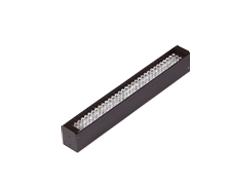 |
| acA1300-60gmNIR - Basler ace |
Sony ICX445
ON Semiconductor PYTHON1300
e2V EV76C560
e2V EV76C661 (NIR)
I had an opportunity to compare three of the four, the Sony ICX445 and both e2V sensors.
Since the EV76C661 is optimized for the Near Infrared (NIR) spectrum the test used IR at 950nm.
I wanted to see if the NIR optimized chip was really faster, and by how much. Additionally, would the color neutralization of IR be different based on the sensor.
 |
| xRite color chart used as a standard for setting exposure and gamma between cameras. |
As expected the e2V EV76C661 sensor outperformed the others. The surprise was that the exposure times were over 2x faster than the others. It was 2.3x faster than the e2V EV76C560, and 2.66x faster than the Sony ICX445.
The images below have the same brightness, same working distance, same light, the same IR bandpass filter and the same iris diameter was used between cameras. The only thing that changed was the exposure time.
Note that isn't the same F/stop because the sony required a 16mm lens, while the e2V's used a 25mm lens. To be fair I used the 25mm lens at f/4 to calculate the 6.25mm iris diameter, then set the 16mm lens to f/2.5 in order to create a 6.25mm diameter.
 |
| e2V EV76C661 (NIR) exposure 7100us 25mm Lens f/4.0 |
 |
| e2V EV76C560 exposure 16600us 25mm Lens f/4.0 |
 |
| Sony ICX445 exposure 19000us 16mm Lens f/2.56 |
The sensor had no effect on the color sensitivity. Again, that is expected as the color pigments depend more on the wavelength of light than the sensor, this just proves that.
Here's a comparison of each sensors spectral sensitivity.
And the one not tested:
One last take-away, The Sony sensor did really well compared to the noraml e2V chip. The Sony pixels are much smaller, 3.75um compared to 5.3um. So with 41% more area the e2V EV76C560 was only 14% faster.





No comments:
Post a Comment